تتمتع تقنيات اتخاذ القرار الجماعي بطريقة تتجاوز البراعة الفردية وتخلق سيمفونيات من الذكاء الجماعي.
تحتفي هذه الأساليب بالتنوع وتفسح المجال أمام تدفق الأفكار بحرية، وتوجه فريقك نحو القرارات والنجاح.
من جلسات العصف الذهني النابضة بالحياة إلى المنهجيات المنظمة التي تسخّر قوة وجهات النظر المتنوعة، فإن اتخاذ القرارات الجماعية هو جوهر العمل الجماعي الحديث. 🤝
يستكشف هذا الدليل أفضل تقنيات اتخاذ القرارات الجماعية لمواءمة أعضاء فريقك في سلسلة متناغمة من الأفكار الإبداعية والحلول المحتملة.
ما هو اتخاذ القرارات الجماعية؟
اتخاذ القرارات الجماعية هو نهج تعاوني يقوم فيه الأشخاص بشكل جماعي بمناقشة وتحليل وتقييم الخيارات المختلفة لحل المشاكل وإيجاد أفضل الحلول. ويُستخدم في سياقات مختلفة، بما في ذلك اجتماعات العمل والأوساط الأكاديمية والمنظمات المجتمعية والمجموعات الاجتماعية.
يُعرف أيضًا باسم عملية صنع القرار تتميز بتبادل الأفكار ووجهات النظر والمعلومات بين أعضاء الفريق. يتعاون أعضاء الفريق أثناء استكشافهم للحلول الممكنة وأساليب حل المشكلات لتحقيق توافق في الآراء أو اتفاق الأغلبية.
على سبيل المثال، قد تعمل مجموعة صغيرة معًا لتحليل مشكلة محددة داخل مؤسستهم، مع استكمال جلسات العصف الذهني والاجتماعات الديناميكية.
بعد استكشاف الأفكار والآراء والخيارات المختلفة بعناية، تختار المجموعة حلاً يتمتع بأفضل فرصة لمعالجة المشكلة.
لاحظ أن ديناميكيات اتخاذ القرارات الجماعية تنطوي على تفاعل الآراء الفردية والتفضيلات والخبرات داخل المجموعة، ويمكن أن يؤثر كل جانب من هذه الجوانب على النتيجة.
أهمية اتخاذ القرارات الجماعية
تأتي أهمية اتخاذ القرارات الجماعية من تجاوز الذكاء الفردي واستخدام الذكاء الجماعي لتعزيز الابتكار والنجاح.
فيما يلي بعض الطرق التي تفيد تقنيات اتخاذ القرارات الجماعية في فرق العمل والمؤسسات:
- تحسين حل المشكلات الإبداعية وتبسيط العمليات داخل مؤسستك من خلال الاستفادة من أفكار جميع أعضاء الفريق، وليس فقط القادة والخبراء
- زيادة التأييد والحماس لأعضاء الفريق وأصحاب المصلحة من خلال إشراكهم وإشعارهم بالاحترام
- التخفيف من المخاطر وتحديد المخاطر المحتملة في وقت مبكر من خلال استكشاف عدة وجهات نظر حول إيجابيات وسلبيات كل خيار
- استفد من نقاط القوة والخبرة التي تتمتع بها مواردك البشرية من خلال مشاركة عملية ومسؤوليات طرق اتخاذ القرار مع الجميع
يمكن أن تطول القائمة، ولكنك هنا من أجل التقنيات، لذا سنتوقف عند هذا الحد. باختصار، يحدث السحر عندما تضع مجموعة متنوعة من الأشخاص عقولهم معًا.
التحديات الشائعة في اتخاذ القرارات الجماعية
مثل عملية اتخاذ القرارات الفردية، من المهم أن تكون على دراية بالعيوب المحتملة لعملية اتخاذ القرارات الجماعية. ففي نهاية المطاف، لا يوجد شيء مثالي، ويمكن تنفيذ كل شيء تقريبًا بشكل سيء.
إحدى أكثر المشاكل شيوعًا هي التفكير الجماعي. عندما يحدث هذا، تعطي المجموعة الأولوية للانسجام على التفكير النقدي، مما يؤدي في كثير من الأحيان إلى قرارات معيبة وغير عقلانية.
هناك مشكلة شائعة أخرى في عملية صنع القرار التعاوني وهي أن عدم الانسجام التعاون الجماعي غالبًا ما يستغرق وقتًا طويلاً. وبعبارة أخرى، يؤدي اتخاذ القرارات الجماعية في بعض الأحيان إلى قرارات سيئة وإضاعة الوقت.
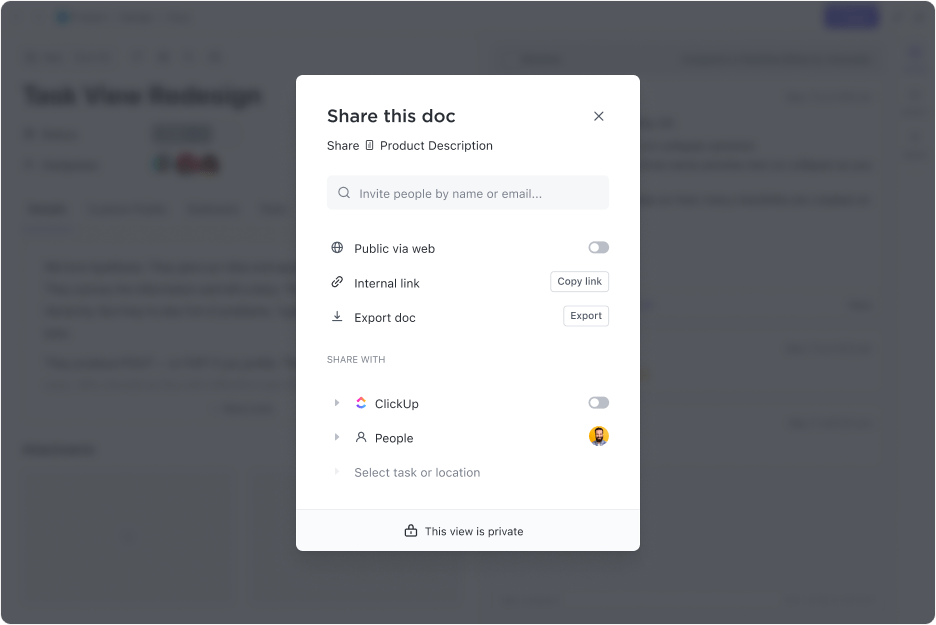
التعاون هو المفتاح مع ClickUp 3.0 Docs حتى تتمكن من المشاركة أو تعيين الأذونات أو التصدير بسرعة إلى المستخدمين الداخليين أو الخارجيين
يعد استخدام تقنيات صنع القرار الجماعي التي أثبتت جدواها طريقة رائعة لتجنب هذه المزالق وجني فوائد مثل تحسين الإبداع وتخفيف المخاطر والمشاركة.
10 أساليب اتخاذ القرارات الجماعية الفعالة
يستفيد كل عضو في المجموعة من إيجاد الصيغة الصحيحة لبراعة فريقك في اتخاذ القرارات. يتعلق الأمر كله بتحديد التركيبة الصحيحة التي يحتاجها فريقك لاتخاذ قرارات أفضل.
ستحتاج إلى تقنيات وأدوات مختلفة لصنع القرار اعتمادًا على مشكلتك ومؤسستك وأهدافك وأعضاء مجموعتك.
راجع هذه الأساليب والأدوات العشرة لصنع القرار الجماعي لفهم ما يناسبك أنت وفريقك.
1. جلسات العصف الذهني
العصف الذهني هو أسلوب جماعي لصنع القرار الجماعي يحتضن التوليد التلقائي والتعاوني للأفكار المتنوعة.
ومن خلال القيام بذلك، يعزز أعضاء المجموعة الحلول الإبداعية ويشجعون على استكشاف الاحتمالات دون عوائق التحيزات.
ألا تحب العصف الذهني التقليدي؟ لا بأس بذلك! ألواح كليك أب البيضاء أعادت تعريف عمليات العصف الذهني وصنع القرار الجماعي من خلال تزويد الفرق بلوحة تفاعلية لتحويل الأفكار إلى إجراءات مؤثرة. فهي تكسر حواجز التواصل وتشجع التدفق الحر للأفكار.
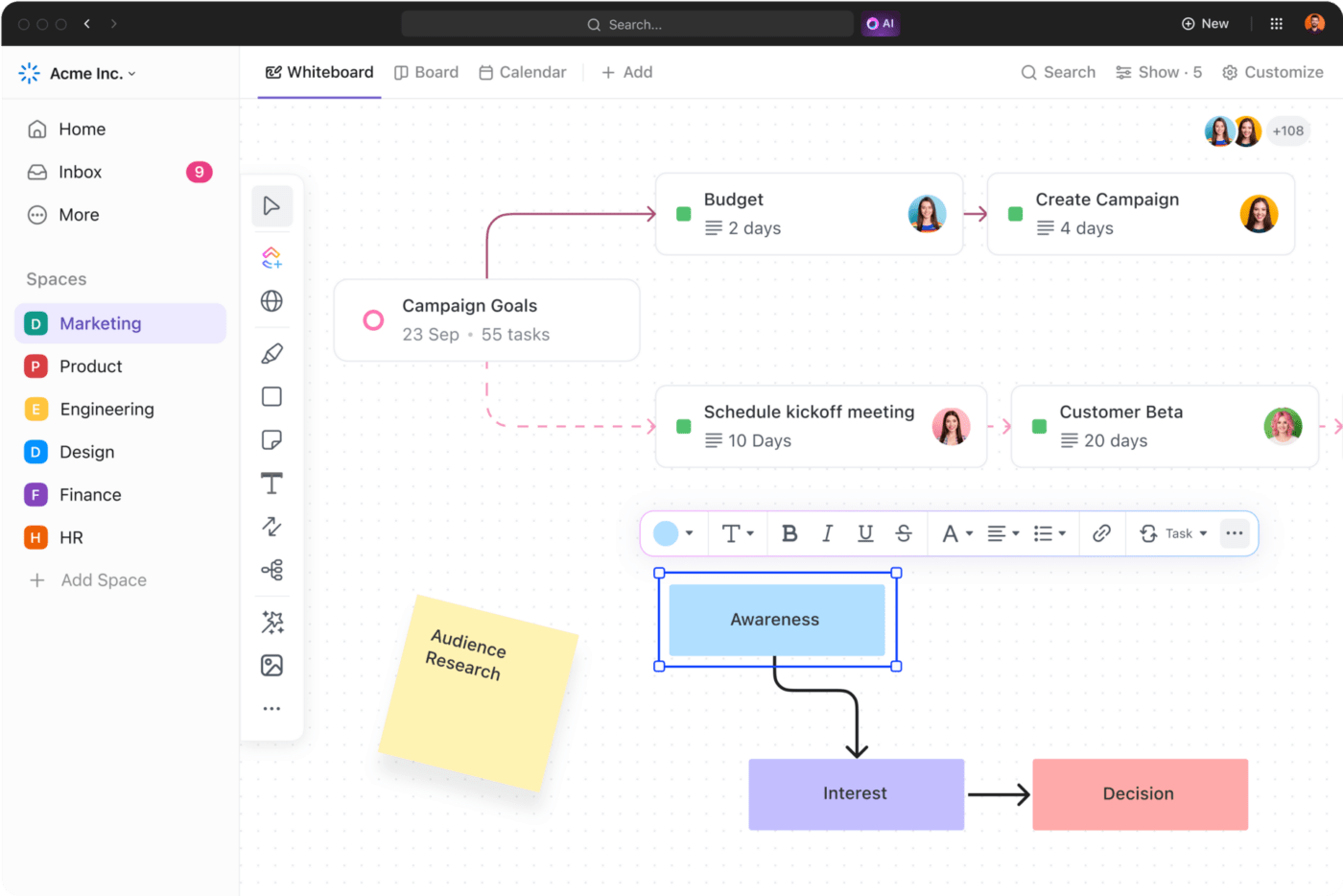
العصف الذهني أو وضع الاستراتيجيات أو تخطيط سير العمل باستخدام سبورة ClickUp Whiteboards التعاونية المرئية
تعمل التعليقات التوضيحية والتعليقات وردود الفعل على تسهيل التعليقات الفورية وتحويل السبورة البيضاء إلى مساحة يتم فيها تقييم مدخلات كل عضو في الفريق. كشف التعاون ClickUp Collaboration يمكّن الجميع - حتى الفرق البعيدة - من تبادل الأفكار على نفس السبورة البيضاء في نفس الوقت، مما يخلق سيمفونية بصرية من التألق.
### 2. الاستفسار الجدلي
الاستقصاء الجدلي هو عملية منظمة تقسم أعضاء الفريق إلى مجموعتين فرعيتين. ثم تقوم كل مجموعة فرعية بتشكيل واستكشاف مجموعة من وجهات النظر المتعارضة والحجج المتناقضة.
وبعد أن يقدم الطرفان حلولهما البديلة، تتناقش المجموعة للاتفاق على مجموعة واحدة من وجهات النظر. يمكن أن يتضمن القرار النهائي عناصر من نهج واحد أو كلا النهجين أو لا شيء منهما.
هذه طريقة جيدة لخلق جدول أعمال الاجتماع يمنع التفكير الجماعي من تخريب القرارات المهمة.
ومن خلال الاستكشاف المنهجي لوجهات النظر المتضاربة، يسعى الاستقصاء الجدلي إلى الكشف عن الافتراضات الخفية وتحديد العثرات المحتملة وتشجيع التفكير النقدي. كما أنه يسخّر قوة الصراع البنّاء ويعزز بيئة تكون فيها المعارضة حافزًا للابتكار.
3. شجرة القرار
شجرة القرار تشبه شجرة القرار لوحة العصف الذهني تقدم تمثيلًا مرئيًا منظمًا للبدائل والنتائج المحتملة المرتبطة بسلسلة من الخيارات أو الإجراءات. 🌳
تبدأ أشجار القرار عادةً بعقدة واحدة تتفرع إلى عدة نتائج محتملة. تعمل كل نتيجة بمثابة عقدة تتفرع إلى احتمالات إضافية وتخلق خريطة شاملة لمسارات القرارات المحتملة.

ارسم روابط بين أي شكل أو وسائط على السبورة البيضاء لإنشاء مخطط انسيابي في ClickUp
يصبح هذا الأسلوب أكثر سهولة عند استخدام السبورة البيضاء من ClickUp. تجعل السبورة البيضاء إنشاء شجرة قرارات مرئية أمرًا بسيطًا وتخطيط مناقشات المجموعة وفقًا لذلك. وبفضل الواجهة المباشرة وسهلة الاستخدام، يحصل الجميع على فكرة أفضل عن الأفكار والإمكانيات التي يتم استكشافها.
4. مناصرة الشيطان
يكون لعب دور محامي الشيطان مفيدًا عند القيام به بشكل صحيح، خاصة في عملية اتخاذ القرارات الجماعية.
عليك أن تبدأ بتعيين شخص واحد أو مجموعة من الأشخاص ليكونوا منتقدين لكل فكرة تُطرح على طاولة النقاش. وهذا يمكن أن يمنع التفكير الجماعي، ويحسن ديناميكيات المجموعة، ويسلط الضوء على القرارات التي يحتمل أن تكون محفوفة بالمخاطر أو مكلفة.
استخدام برنامج تعاون الفريق مثل ClickUp يجعل هذا الأمر أسهل من خلال منح الفرق طرقًا متعددة لتوصيل أفكارهم وأفكارهم. تعمل هذه التقنية مع جميع أنواع الاجتماعات أيضًا

تعاون بصريًا مع أعضاء الفريق داخل ClickUp Whiteboards لتبادل الأفكار وتحويلها إلى عناصر قابلة للتنفيذ
على سبيل المثال، تخيل سيناريو تستخدم فيه مجموعتك سبورة ClickUp Whiteboards لجلسة العصف الذهني. هنا، يقوم المدافعون عن الشيطان بالتعبير عن انتقاداتهم بسلاسة من خلال التعليقات وردود الفعل والتعليقات التوضيحية المرتبطة مباشرةً بأفكار وأفكار محددة.
وهذا يسمح للفريق بأكمله بالمراجعة والمناقشة قبل الوصول إلى مسار العمل الأكثر استنارة واستراتيجية.
5. ديمقراطية اتخاذ القرار
يتخلص صنع القرار الديمقراطي من فكرة وجود صانعي قرار معينين. إنه نظام تصويت والأغلبية هي التي تحكم.
يعمل هذا الأسلوب بعدة طرق مختلفة. التطبيق الأكثر وضوحاً هو التوصل إلى القرار النهائي بناءً على تصويت جماعي.
ومع ذلك، فإن أعضاء الفريق الذين صوتوا لصالح قرار مختلف عن القرار الذي "يفوز" لا يشعرون أحيانًا بالحماس نفسه لدعمه. إذا كان قائد المجموعة المعين يعتقد أن هذا احتمال وارد، فإن اتخاذ القرار الديمقراطي مفيد أيضًا في تضييق نطاق البدائل المحتملة التي تناقشها اجتماعات مجموعتك.
إن الاستبيانات التي يتم تسليمها إلى ميسر الفريق تبقي تصويت الجميع مجهولاً وتمكن الناس من التصويت بصدق، مما يقلل من خطر التفكير الجماعي.
يمكن للتصويت الديمقراطي أيضًا أن يسرع عملية اتخاذ القرار الجماعي عندما تصل إلى مرحلة الاستقرار.
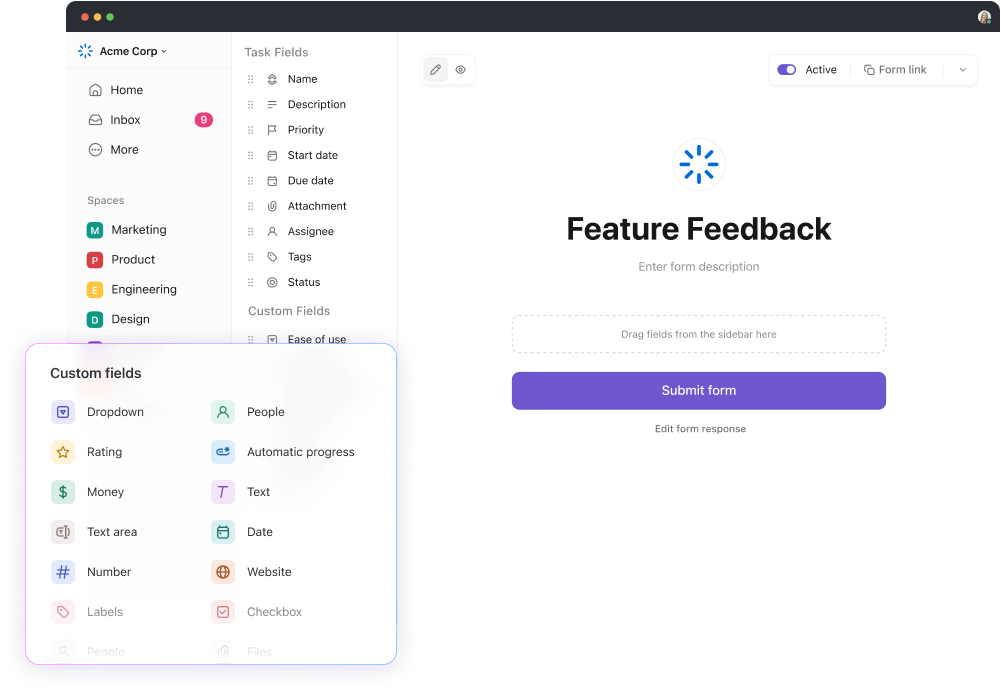
قم بسحب وإسقاط الحقول المخصصة في طريقة عرض النموذج لصياغة استطلاعات شاملة أو جمع الملاحظات في ClickUp 3.0 طريقة عرض نموذج ClickUp بتبسيط عملية جمع الأصوات من خلال تمكين أعضاء الفريق من تقديم آرائهم وتفضيلاتهم في ثوانٍ معدودة.
6. تقنية المجموعة الاسمية
تعمل تقنية المجموعة الاسمية (NGT) على تسخير الرؤى الجماعية للأفراد مع الحفاظ على نهج منظم. وبعبارة أخرى، فإنها تجعل العصف الذهني أكثر عملية موحدة .
يتم تشجيع أعضاء المجموعة على توليد الأفكار بشكل مستقل ثم مشاركتها مع المجموعة. يؤدي ذلك إلى تسريع اتخاذ القرارات والتوافق الجماعي، خاصةً بالنسبة للمشاريع التي تتطلب تعاون متعدد الوظائف .
يشارك كل عضو في الفريق أفكاره دون مناقشة. بمجرد أن يقدم الجميع أفكارهم، تقوم المجموعة بمناقشتها لتوضيح النقاط. ثم تقوم عملية تصويت منظمة بترتيب الاقتراحات حسب الأولوية والجدوى.
7. تقنية دلفي
تستخلص تقنية دلفي حكمة جماعية من خبراء في الموضوع مع الحفاظ على عدم الكشف عن هويتهم. تقوم المجموعة بتعيين ميسر لطرح أسئلة مفتوحة على فريق من الخبراء للحصول على إجابات مستقلة ومجهولة الهوية.
ثم يقوم الفريق أو الميسر بتجميع هذه الردود وتلخيصها ومشاركتها مع مجموعة الخبراء للحصول على مزيد من الملاحظات. تتكرر عملية التجميع والتلخيص والمشاركة هذه حتى يتم التوصل إلى قرار.
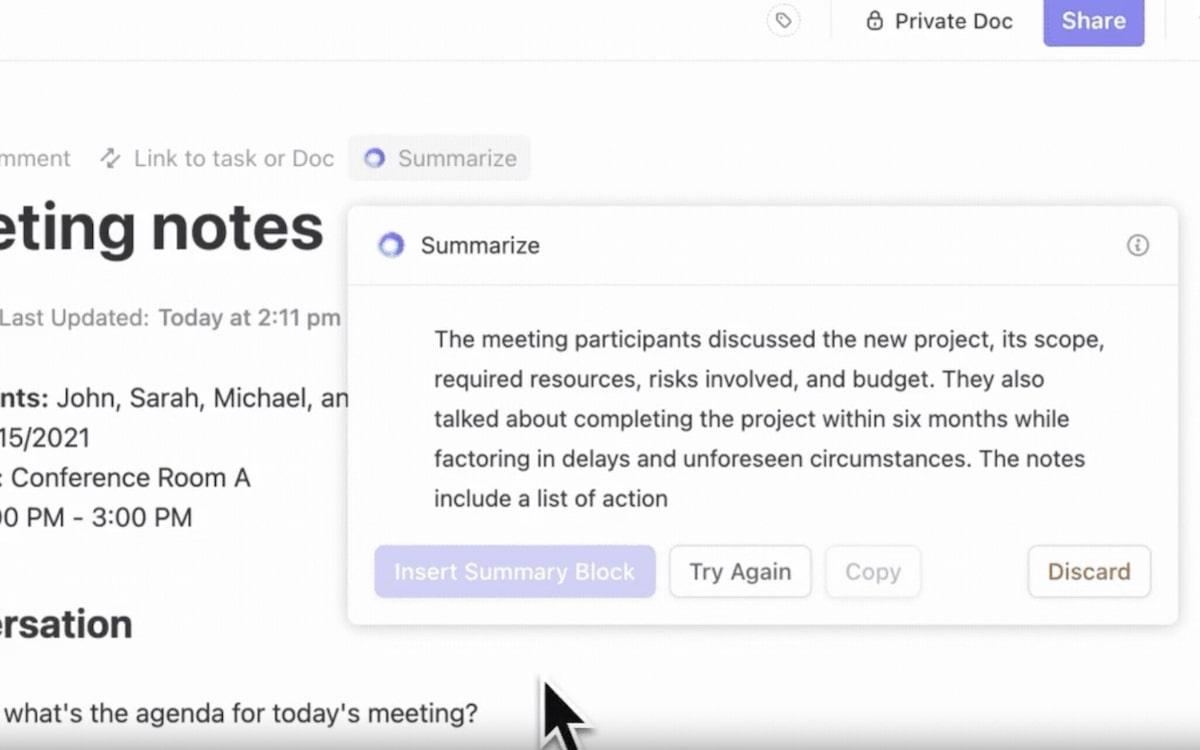
تلخيص ملاحظات الاجتماع في ثوانٍ باستخدام ClickUp AI
تهدف طريقة دلفي إلى التخفيف من تأثير الشخصيات المهيمنة والسلوك التنظيمي وديناميكيات المجموعة حتى يتمكن الخبراء من المساهمة دون مواجهة.
ويعتبر هذا التبادل المنهجي للمعلومات والآراء فعالاً بشكل خاص في عمليات صنع القرار المعقدة والتخطيط الاستراتيجي والسيناريوهات الأخرى التي تكون فيها الخبرات المتنوعة أمرًا بالغ الأهمية.
8. القرارات بالإجماع
يشير الإجماع في عملية اتخاذ القرارات الجماعية إلى الحالة التي يوافق فيها كل شخص ويدعم مسار العمل المقترح. 🙌
غالبًا ما تتعامل الفرق مع أسلوب الإجماع كمناقشة مفتوحة أو مشاركة المعلومات أو جلسة عصف ذهني. يتم اتخاذ القرار النهائي بمجرد أن يتوصل الجميع إلى توافق في الآراء بتأييد جماعي ومنظور مشترك.
إن تحقيق هذا المستوى من الانسجام والتماسك في المجموعة أمر رائع، لكنه غالبًا ما يستغرق وقتًا طويلاً. أي شخص أمضى أيامًا في هيئة المحلفين في محاولة للتوصل إلى حكم بالإجماع قد يتذلل (بشكل مفهوم) عند ذكر هذه التقنية.
مع أخذ عنصر الوقت في الاعتبار، فإن القرارات بالإجماع هي الأفضل في المواقف التي تتطلب اتفاقًا تامًا لنجاح أو قبول مسار العمل المختار.
ومع ذلك، قد ترغب في تجربة تقنيات اتخاذ القرارات الجماعية الأخرى في هذه القائمة للقرارات الأصغر حجمًا.
9. اجتماعات الوقوف اجتماعات الوقوف هي عكس أسلوب اتخاذ القرارات الجماعية بالإجماع. فهي مصممة لتكون قصيرة وفعالة دون إهدار أي وقت ضائع، لذلك غالبًا ما تُعقد واقفًا (أو سيرًا على الأقدام أحيانًا).
تتضمن هذه الاجتماعات قيام كل عضو من أعضاء الفريق بالتناوب في مناقشة على شكل دائرة، والإجابة على أسئلة بسيطة مثل هذه الأسئلة:
- ماذا فعلت بالأمس؟
- ماذا تخطط للقيام به اليوم؟
- هل هناك أي شيء يعيق تقدمك؟
قم بتعديل هذه الأسئلة وتوسيع نطاقها لمعالجة القرار المحدد الذي يحاول فريقك اتخاذه. بعد ذلك، استخدم الأفكار والمعلومات التي تم جمعها من هذا الاجتماع التحضيري لاتخاذ قرار في اجتماع أكثر رسمية.
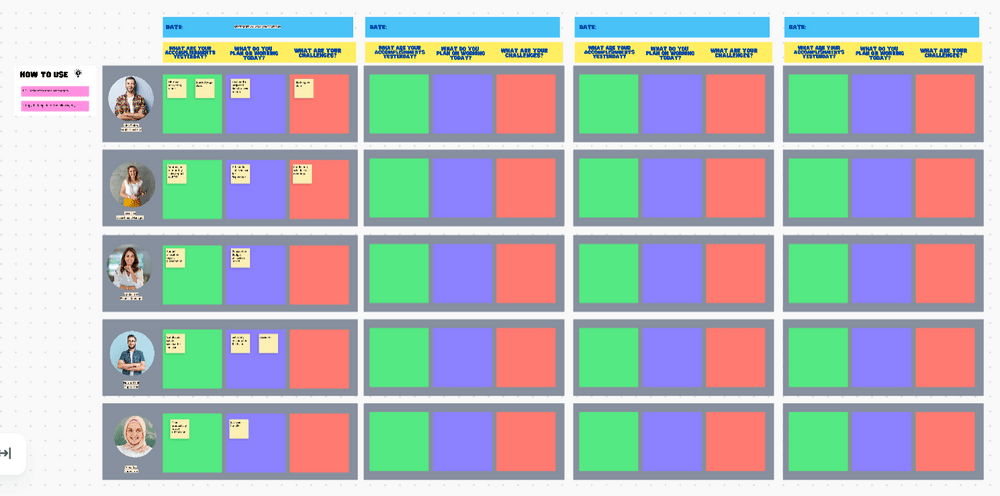
استخدم السبورة التعاونية ClickUp Whiteboard لالتقاط جميع الأفكار والقرارات من اجتماع الاستعداد
الهدف من اجتماع الاستعداد اليومي هو المساعدة في تنسيق الفريق. تساعد حلقة التغذية الراجعة السريعة هذه الفرق على التوافق والبقاء على المسار الصحيح، على غرار اجتماع كرة القدم. إذا ظهرت مشكلة ما، يمكنك معالجتها بسرعة وإبقاء المشاريع على المسار الصحيح. قالب اجتماع الاستعداد اليومي في ClickUp يمنحك كل ما تحتاجه للتخطيط وتدوين الملاحظات وتتبع تقدم المشروع. قم بإقرانه مع قالب جدول أعمال اجتماع الوقوف من ClickUp للتخلص من التخمين وتحسين عملية اتخاذ القرارات الجماعية لفريقك.
10. رقمي أدوات اتخاذ القرار
يمكن لأدوات وتطبيقات اتخاذ القرار الصحيحة تحسين كل تقنية في هذه القائمة. 🛠️
على الرغم من أننا قدمنا بالفعل بعض الأمثلة على كيفية استخدام ClickUp في التقنيات الأخرى في هذه القائمة، إلا أنها مفيدة لأكثر من ذلك بكثير. استخدم ClickUp للفرق لمساعدة أعضاء فريقك في كل جانب من جوانب إدارة المشاريع واتخاذ القرارات، بغض النظر عن القسم أو حجم شركتك (أو حجمها).
على سبيل المثال, عرض دردشة ClickUp يجمع كل الاتصالات والمحادثات حول القرار معًا على منصة واحدة. وهذا يجعل من السهل مراجعة المعلومات والأفكار والمساهمات الموجودة بشكل أكثر كفاءة.
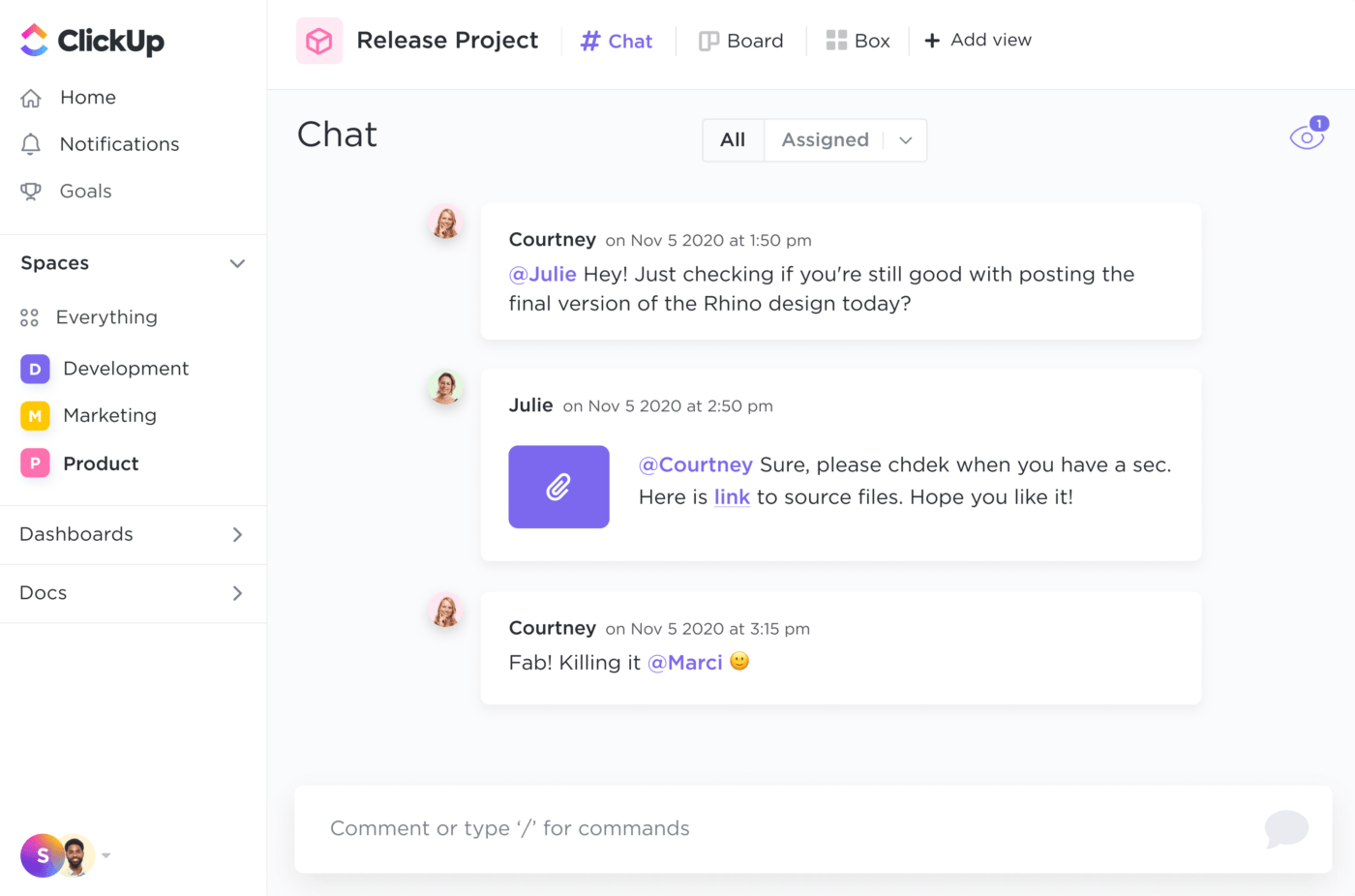
تقوم طريقة عرض الدردشة بتخزين جميع تعليقاتك في ClickUp للعثور بسرعة على أي محادثة
الـ نموذج خطة الاتصال ClickUp أداة رائعة أخرى للاستفادة منها. استخدمه لتحسين أي من هذه الأساليب (أو جميعها) من خلال تحسين التواصل، سواء كان فريقك يعمل عن بُعد أو مختلط أو في الموقع.
هذا مجرد نموذج واحد من بين أكثر من 1000 نموذج يقدمه ClickUp لتحسين اتخاذ القرارات وإدارة المشاريع وكفاءة الاجتماعات.
على سبيل المثال، يمكنك استخدام قوالب قائمة المهام لإنشاء هيكل لاجتماع اتخاذ القرار الخاص بك في وقت مبكر أو العمل كفريق لتحسين قائمة المهام لمشروع معين.
كما توفر لك أدوات اتخاذ القرار الرقمية مثل ClickUp الوقت من خلال أتمتة المهام اليومية، وإنشاء ملخصات الذكاء الاصطناعي لاجتماعاتك، وتتبع تقدم المشروع، وإبقاء أعضاء الفريق على نفس الصفحة.
قم بتنسيق عملية اتخاذ القرارات الجماعية الخاصة بك
يعد اختيار عمليات اتخاذ القرارات الجماعية الصحيحة أمرًا بالغ الأهمية لخيارات ناجحة ومبتكرة.
تذكر أن كل عضو من أعضاء الفريق يلعب دورًا فريدًا في صياغة التحفة الفنية الجماعية التي هي عبارة عن قرار مدروس جيدًا. استخدم تقنيات اتخاذ القرارات الجماعية المذكورة أعلاه لدفع أعضاء فريقك (ومؤسستك) نحو مستقبل سعيد ومتناغم.
لقد حان الوقت لتبني تقنيات مثل العصف الذهني، والتصويت الديمقراطي، والتصويت الديمقراطي، وأسلوب NGT، وطريقة دلفي لخلق بيئة تعزز القرارات والاستراتيجيات ذات الرؤية.
اختبر القوة التحويلية لمنصة تعمل على تبسيط جهودك التعاونية وتحويل الأصوات المتنوعة لفريقك إلى تحفة فنية متناغمة. اشترك في ClickUp اليوم -إنه مجاني!
